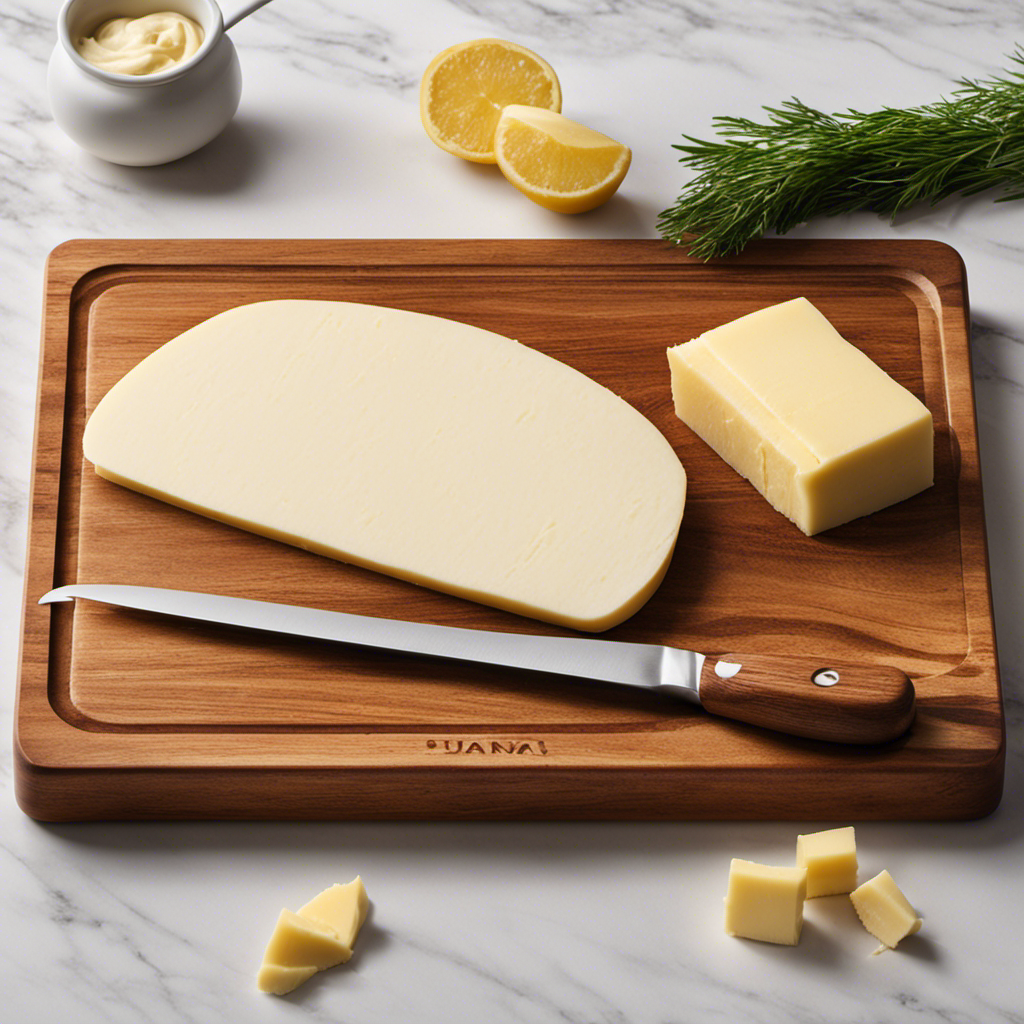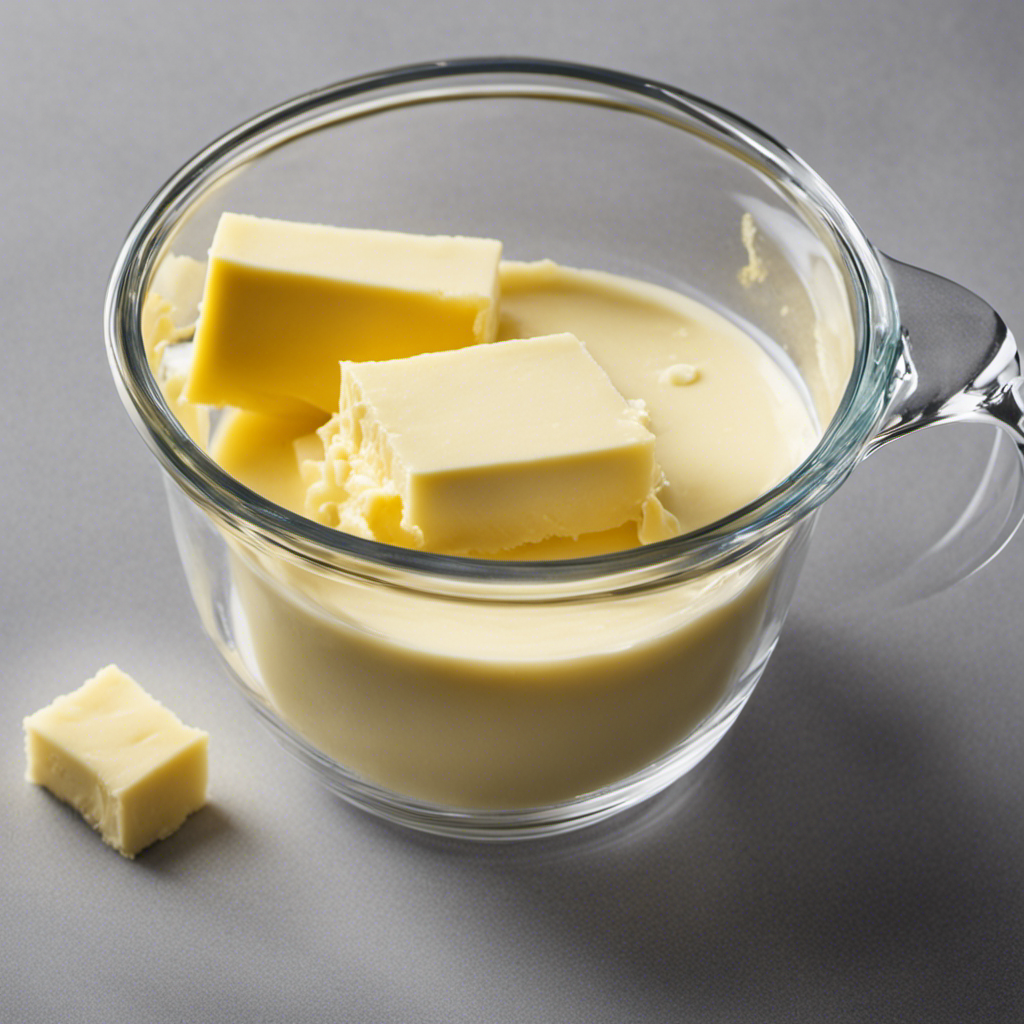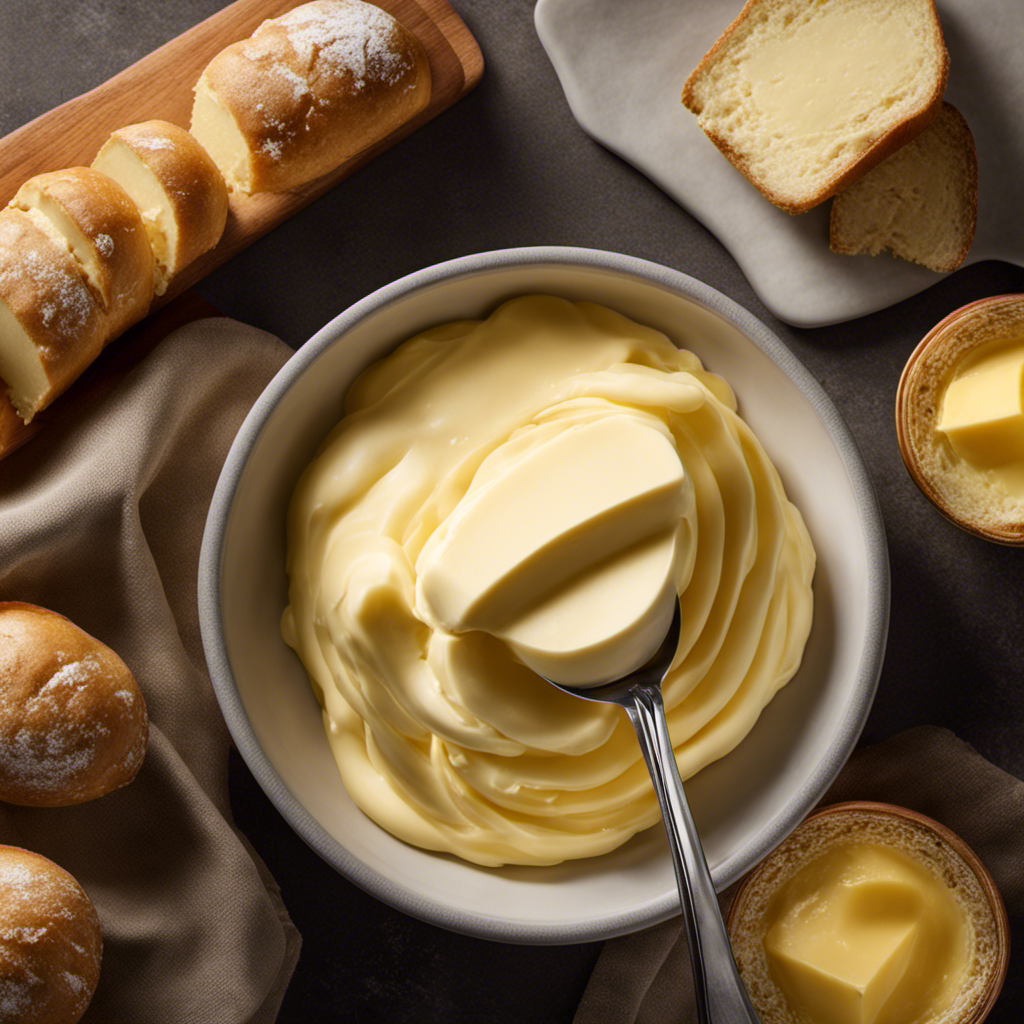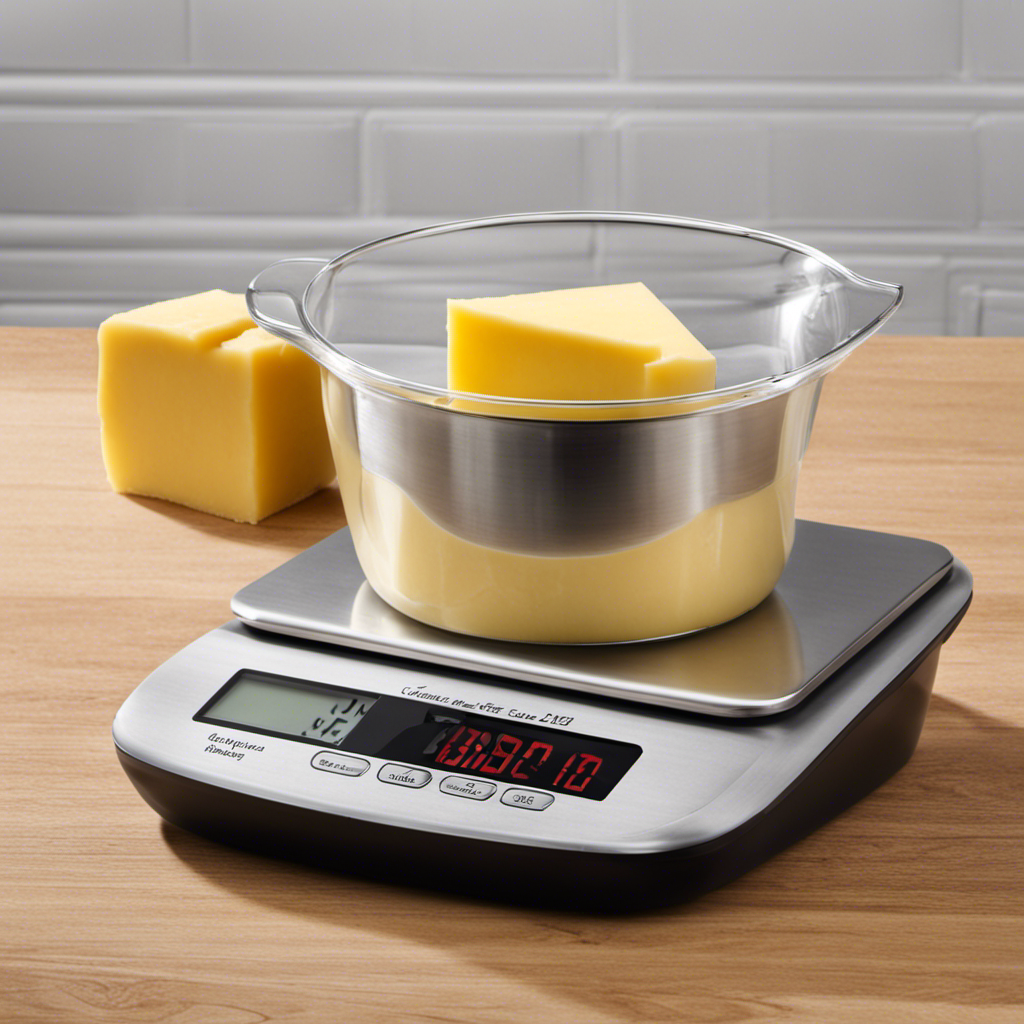Were you aware that a single stick of butter weighs 113 grams?
Understanding butter measurements is essential for precise cooking and baking. In this article, I will guide you through converting butter measurements to grams, provide a handy conversion guide, and share common recipes that use specific butter measurements.
Whether you’re adjusting butter measurements for baking or simply need to know the equivalents in grams, cups, or sticks, this article has got you covered.
Let’s dive in and demystify the world of butter measurements!
Key Takeaways
- A stick of butter weighs around 113 grams or 4 ounces.
- One stick of butter is equivalent to 8 tablespoons or 1/2 cup.
- Accurate butter measurements ensure consistent results in baking and cooking.
- Understanding global butter conversions helps navigate different measurement systems.
Understanding Butter Measurements
There’s a lot to learn about butter measurements. Understanding the different butter measurements and equivalents can be quite helpful in the kitchen.
When it comes to butter, there are various measurements used, such as sticks, tablespoons, cups, and grams. A stick of butter typically weighs around 113 grams or 4 ounces. This is equivalent to 8 tablespoons or 1/2 cup.
Knowing these conversions can make it easier to follow recipes and achieve the desired results. For example, if a recipe calls for 1/4 cup of butter, you can easily measure it by using 4 tablespoons or cutting a stick in half.
Having a good grasp of butter measurements ensures accurate and consistent results in your baking and cooking endeavors.
The Standard Stick of Butter Size
To determine the size of a standard stick of butter, you typically find 8 tablespoons. However, it’s important to note that different butter packaging options may vary in size.
Some brands offer sticks that contain 4 ounces or 113 grams of butter, while others may have sticks weighing 8 tablespoons or 1/2 cup.
When measuring butter accurately, it’s best to use a kitchen scale for precise results. Simply place the butter on the scale and adjust until you reach the desired weight.
If you don’t have a scale, you can use the tablespoon markings on the butter wrapper or use a measuring spoon. Remember to level off the spoon to ensure accurate measurements.
Converting Butter Measurements to Grams
When converting measurements, it’s helpful to use a kitchen scale for accurate results. Understanding butter conversions is essential for precise baking.
Butter is typically measured in sticks, tablespoons, or grams. To convert butter measurements to grams, it’s important to know that one stick of butter equals 113 grams. This conversion is crucial when following recipes from different countries or using a scale that measures in grams.
By using grams as a standard unit of measurement, you can ensure consistency in your baking.
Now that we understand butter conversions, let’s explore the next step in our conversion guide: grams to ounces.
Grams to Ounces: A Conversion Guide
Converting grams to ounces is a necessary skill for precise baking measurements. It ensures that you have the right amount of ingredients to achieve the desired results. Here are some key points to help you understand the conversion process:
-
Understanding butter ratios:
-
Butter is often measured in tablespoons or sticks.
-
A stick of butter typically weighs 113 grams or 4 ounces.
-
It is equivalent to 8 tablespoons or 1/2 cup.
-
Converting grams to tablespoons:
-
To convert grams to tablespoons, divide the weight in grams by the conversion factor for the specific ingredient.
-
The conversion factor for butter is 14 grams per tablespoon.
-
Converting grams to ounces:
-
To convert grams to ounces, divide the weight in grams by 28.35, which is the conversion factor for grams to ounces.
How Many Grams in One Stick of Butter
One stick of butter typically weighs 113 grams or 4 ounces. Understanding butterfat content is important when calculating butter portions for recipes. Butterfat content refers to the amount of fat in the butter, which affects its texture and flavor. Higher butterfat content results in a richer and creamier taste.
In the United States, butter is commonly sold in sticks, with each stick containing 113 grams. This standardized measurement makes it easy to measure and use in recipes. However, it’s important to note that different countries may have different butter measurements.
Now, let’s explore the variations in butter measurements around the world.
Different Butter Measurements Around the World
When it comes to global butter conversions, understanding the differences between metric and imperial measurements is crucial. These variations can be seen not only in the measurements themselves, but also in the packaging of butter.
For instance, while some countries use grams or kilograms to measure butter, others rely on pounds or ounces. Additionally, butter packaging can differ in shape, size, and labeling, making it important to be aware of these variations when working with recipes from different regions.
Global Butter Conversions
To understand global butter conversions, you need to know the equivalent grams in a stick of butter.
Butter consumption varies across different countries, with some nations being avid consumers of this creamy delight. According to butter production statistics, the top three countries with the highest butter production are the United States, India, and Germany. These countries not only produce a significant amount of butter but also have a high level of global butter consumption.
Some interesting facts about global butter consumption include:
- In France, the average person consumes around 8 kilograms of butter per year.
- In the United States, butter consumption has been steadily increasing over the years.
- In India, ghee, a form of clarified butter, is a staple ingredient in many traditional dishes.
Understanding global butter conversions helps us appreciate the cultural significance and popularity of this versatile ingredient worldwide.
Metric Vs. Imperial Measurements
Metric and imperial measurements have different units of measurement for weight, volume, and length. When it comes to butter, the packaging options vary across different countries, making it important to understand how to convert butter measurements for cooking. In the table below, I have provided a comparison between metric and imperial measurements for commonly used butter packaging options:
| Butter Packaging Options | Metric Measurement | Imperial Measurement |
|---|---|---|
| Stick of Butter | 125 grams | 4 ounces |
| Block of Butter | 250 grams | 8 ounces |
| Tub of Butter | 500 grams | 1 pound |
Converting between metric and imperial measurements can be a bit tricky, but it’s essential for accurate recipe execution. Knowing the conversions allows you to follow recipes from various sources and cater to different measurement systems. So next time you come across a recipe that calls for a specific amount of butter, you’ll be well-equipped to handle the conversion seamlessly.
Butter Packaging Variations
If you’re unsure about the different packaging options for butter, it’s important to understand the variations in weight and volume. Here are some common butter packaging variations to help you navigate the supermarket aisles:
-
Butter Sticks: The most common packaging option, butter sticks typically come in a rectangular shape with measurements of 4 ounces or 113 grams per stick.
-
Butter Tubs: These are larger containers that can hold varying amounts of butter, usually ranging from 8 ounces (227 grams) to 16 ounces (454 grams).
-
Butter Packets: Often found in restaurants or for individual use, butter packets contain around 1 tablespoon or 14 grams of butter.
Knowing these common butter measurements can be helpful in recipes and cooking. But what if you need to convert grams to another measurement? Let’s explore butter packaging and grams conversion in the next section.
Butter Packaging and Grams Conversion
Butter sticks typically come in packaging that states the number of grams. Understanding butter measurements can be confusing, but the packaging options make it easier.
Most butter sticks in the United States come in packages of 4 sticks, totaling 454 grams or 1 pound. Each individual stick is typically 113 grams or 1/4 pound. The packaging usually includes labels with both the weight in grams and the weight in ounces, making it convenient for consumers to measure out the necessary amount for their recipes.
This standardized packaging helps ensure consistency in recipes and allows for easy conversions between grams and ounces. So, next time you’re baking and need to measure out butter, just check the packaging for the grams measurement and you’ll be good to go!
Common Recipes and Butter Measurements
When it comes to baking and cooking, accuracy is key. Knowing the conversion ratios for different ingredients can ensure that your recipes turn out just right.
In addition, it’s helpful to have knowledge of butter alternatives and substitutions, especially for those who follow a dairy-free or vegan diet.
Lastly, adjusting recipes for consistency is an important skill to have, as it allows you to make necessary modifications based on the ingredients you have on hand or personal preferences.
Conversion Ratios for Accuracy
To ensure accuracy, it’s helpful to know the conversion ratios for different measurements. When it comes to understanding butter measurements and converting them to grams, here are three key points to keep in mind:
-
Stick of Butter: In the United States, a standard stick of butter is equivalent to 113 grams or 1/2 cup.
-
Tablespoon of Butter: One tablespoon of butter weighs about 14 grams.
-
Ounce of Butter: An ounce of butter weighs approximately 28 grams.
Knowing these conversion ratios can be crucial when following recipes that require specific measurements. It ensures that you add the right amount of butter and achieve the desired results.
Now, let’s explore some alternatives and substitutions for butter.
Butter Alternatives and Substitutions
If you’re looking for a healthier option, there are several alternatives and substitutions available for butter in recipes. Whether you’re following a vegan diet or simply want to reduce your saturated fat intake, there are plenty of choices to consider.
One popular option is vegan butter, which is made from plant-based oils like coconut or olive oil. It has a similar consistency and flavor to traditional butter, making it a great substitution in both cooking and baking.
Another alternative is using mashed avocado or banana as a replacement for butter in certain recipes. These options not only add a creamy texture but also provide additional nutrients.
By exploring these butter alternatives, you can easily adapt your recipes to meet your dietary needs and preferences.
Now, let’s dive into adjusting recipes for consistency.
Adjusting Recipes for Consistency
One way to achieve the desired consistency in recipes is by using alternative ingredients such as mashed avocado or banana. These ingredients can replace butter in recipes, making them suitable for individuals with dietary restrictions or those who prefer to avoid dairy.
Adjusting recipes for dietary restrictions is important as it allows everyone to enjoy delicious treats without compromising their health or preferences.
The role of butter in baking is to provide moisture and richness to the final product. However, by using alternatives like avocado or banana, you can still achieve similar results. Avocado adds a creamy texture and healthy fats, while banana brings natural sweetness and moisture.
Experimenting with these alternatives can lead to unique and tasty creations that cater to various dietary needs.
Adjusting Butter Measurements for Baking
You can easily adjust butter measurements for baking by using a kitchen scale. When it comes to baking cookies, accurate measurements are crucial for achieving the perfect texture and flavor.
To measure butter accurately, start by placing your mixing bowl on the kitchen scale and zeroing it out. Then, add the desired amount of butter directly into the bowl. This method ensures precision and eliminates the guesswork involved in measuring butter using cups or tablespoons.
Not only does using a kitchen scale provide more accurate results, but it also allows for consistent results each time you bake. With this simple adjustment, you can confidently follow any recipe and achieve delicious, evenly baked cookies.
Now, let’s explore some tips for accurate butter measurement.
Tips for Accurate Butter Measurement
To ensure precise measurements, it’s important to use a kitchen scale when measuring butter for baking. Here are some tips for accurate butter measurement:
-
Soften the butter: Allow the butter to reach room temperature before measuring. This ensures that it will be easier to measure and incorporate into your recipes.
-
Use a scale: Measuring butter by weight is more accurate than using volume measurements. A kitchen scale allows you to measure the exact amount of butter required.
-
Cut it properly: If your recipe calls for a specific amount of butter, make sure to cut it into precise measurements. Use a ruler or a knife guide to get the perfect size.
By following these tips, you can ensure that your butter measurements are accurate, leading to better baking results.
Now let’s explore the different butter equivalents: grams, cups, and sticks.
Butter Equivalents: Grams, Cups, and Sticks
Using a kitchen scale to measure butter is more accurate than using volume measurements. When it comes to butter measurement conversions, it can be confusing to figure out how many grams are in a stick of butter or how many cups equal a certain amount.
To make things easier, here are some butter measurement equivalents. One stick of butter typically weighs 113 grams or 1/2 cup. This means that if a recipe calls for 1 cup of butter, you would need 2 sticks or 226 grams.
It’s important to note that different brands of butter may have slightly different measurements, so it’s always best to check the packaging or use a kitchen scale for precise measurements.
Frequently Asked Questions
Can I Use Unsalted Butter Instead of Salted Butter in a Recipe?
Yes, you can use unsalted butter instead of salted in a recipe. However, salted butter adds flavor to baked goods. It’s best to adjust the salt in the recipe if using unsalted butter.
How Long Can I Store Butter in the Refrigerator?
The shelf life of butter varies, but it’s best to store it in the refrigerator. Follow these best practices for keeping butter fresh: keep it in an airtight container, away from strong odors, and use within a few months.
Can I Substitute Margarine for Butter in a Recipe?
Yes, you can substitute margarine for butter in a recipe. However, it may affect the taste and texture. Margarine is usually softer than butter, so the end result may be slightly different.
How Much Butter Should I Use to Make a Basic Buttercream Frosting?
To make a basic buttercream frosting, I use a 1:2 ratio of butter to powdered sugar. It creates a creamy and sweet frosting that’s perfect for decorating cakes and cupcakes. Here are some tips for decorating with buttercream frosting.
Is There a Difference in the Texture and Taste of Butter Made From European-Style Cream Compared to Regular Butter?
Using different types of cream in butter making can result in a difference in flavor and texture. European-style butter made from high-fat cream has a richer taste and smoother texture compared to regular butter made from lower-fat cream.
Conclusion
In conclusion, understanding butter measurements is essential for any cooking or baking enthusiast. Converting butter measurements to grams allows for more precise and accurate recipes.
The standard stick of butter weighs approximately 113 grams, making it easy to calculate the amount needed for various dishes. Whether you’re making fluffy pancakes or decadent cookies, knowing the correct butter measurement ensures perfect results every time.
So, grab a stick of butter, feel its smoothness, and let it melt into your culinary creations.










